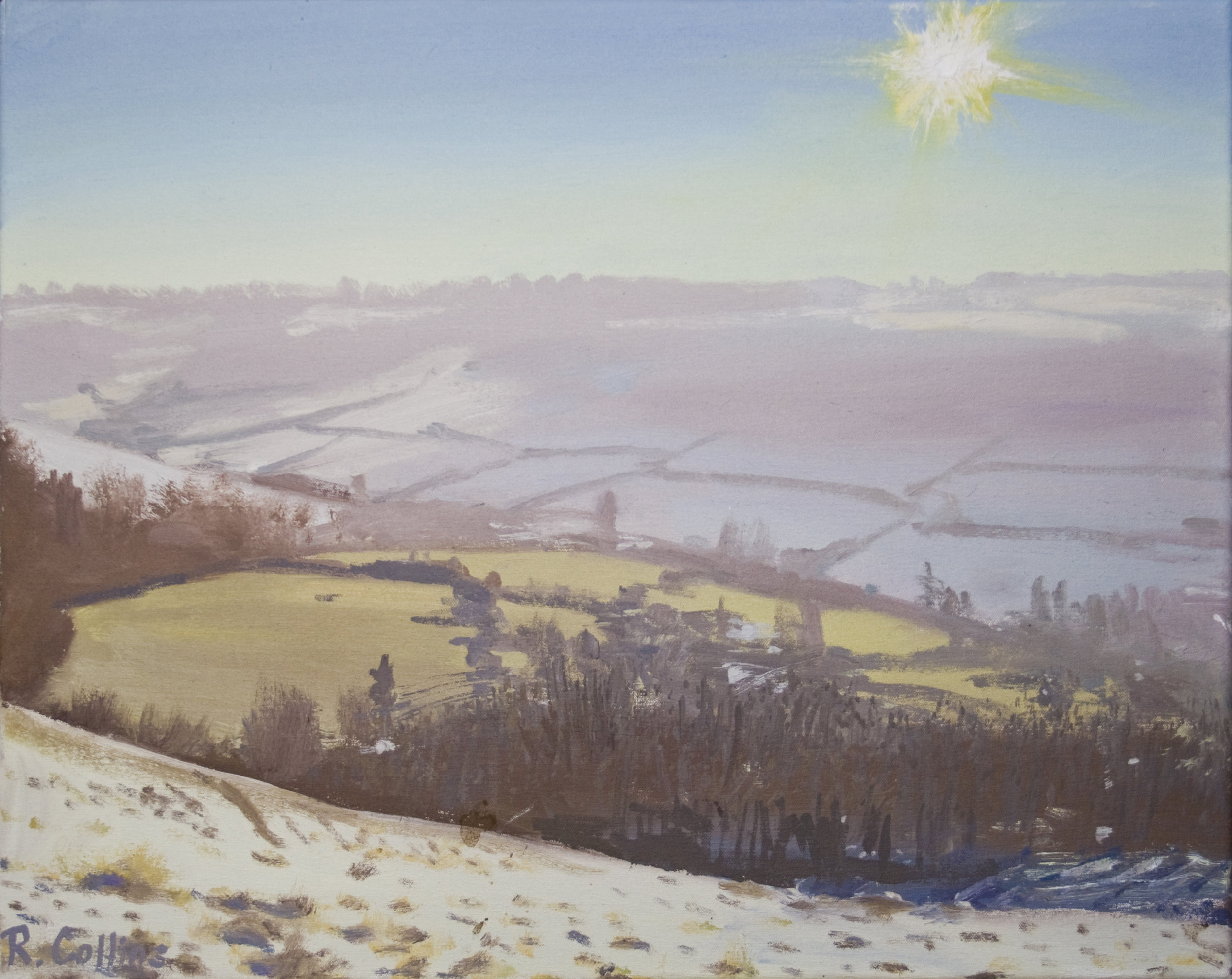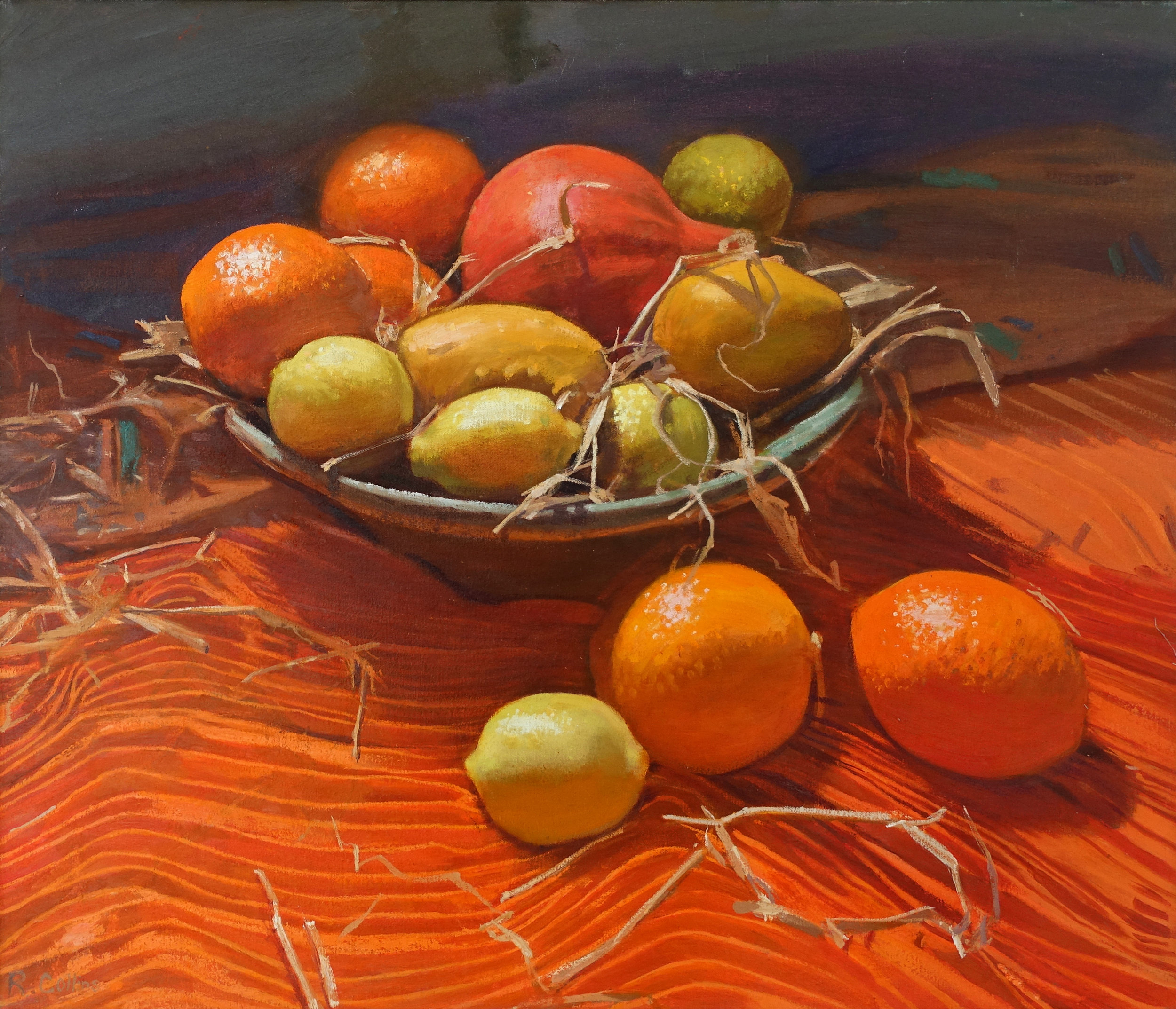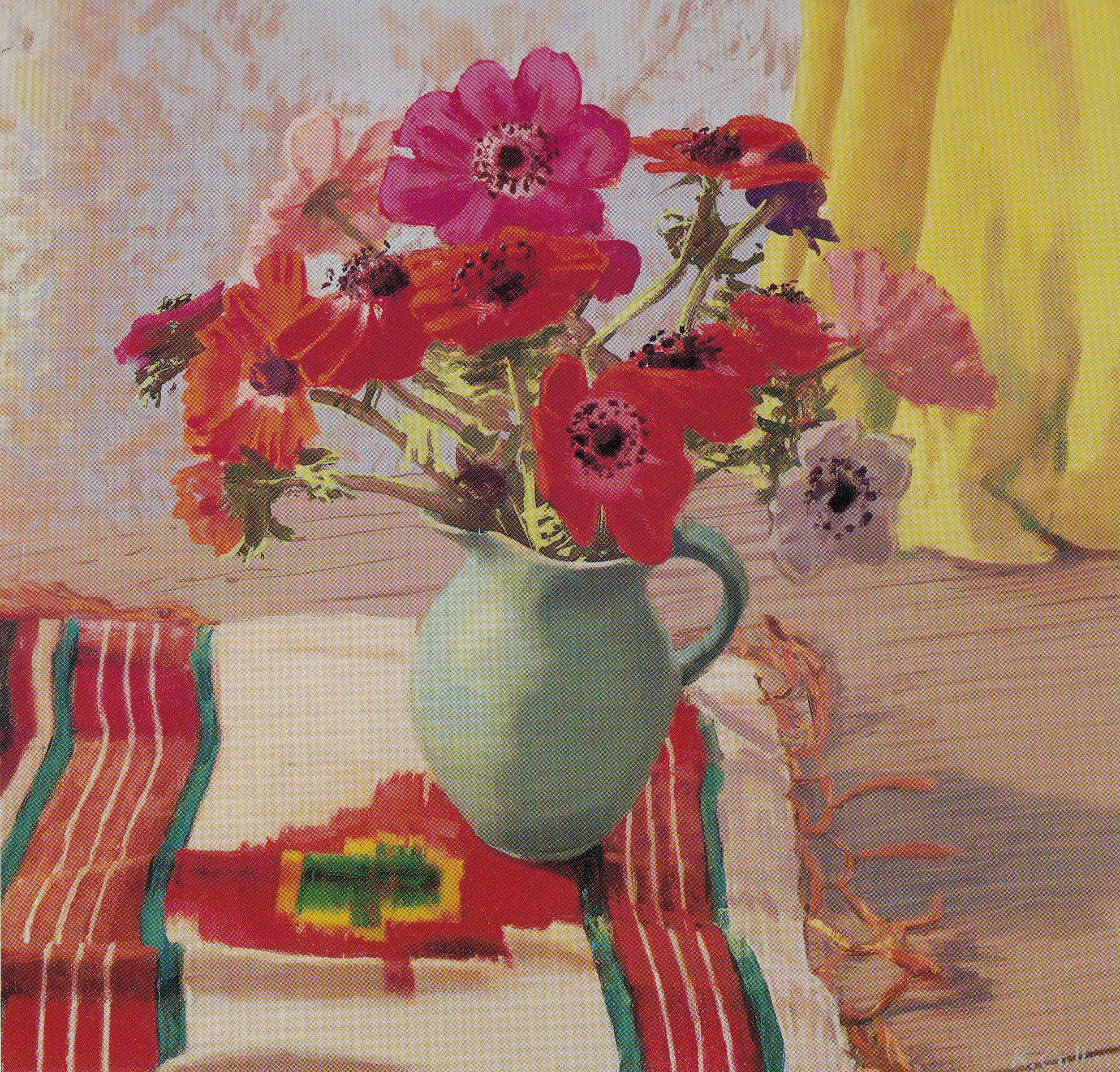Robert Collins
Robert Collins was born in Gloucestershire in 1952 and educated at Gloucestershire College of Art and the Royal College of Art in Kensington.
He is a versatile painter working mostly in oil and expressing himself with equal conviction in landscape, still life and sometimes portrait, interiors and architectural subjects. All these become vehicles for the expression of light, space and atmosphere but despite their realism they all have an essential underlying abstract structure with finely balanced judgements of colour, shape and composition.
Since 1984 Rob has been represented by The Francis Kyle Gallery where he has had five one-man-shows and contributed to seventeen group shows.
In 1981 Rob was a founder member of Red Herring Studios in Brighton, a group studio set up and run by 27 artists and craftspeople. In 1989 he moved back to Gloucestershire where he now lives and works. In 2003 he helped set up Under the Edge Arts, a thriving community arts project. He teaches painting and art history. In August 2009 Rob spent an hour on the ‘Fourth Plinth’ as part of Antony Gormley’s ‘One and Other’ project. He used his hour to paint the view across Trafalgar Square. He is a devoted countryman with a love of nature, he has always been interested in the process of seeing and of recording what he sees in paint.
Reviews
March 2020 Cotswold Life Magazine Candia McKormack wrote:
Close To The Edge - Rob Collins is one of those rare artists who, in a few instinctive brush strokes, captures the breathtaking beauty of the Gloucestershire countryside.
I’m standing next to Gloucestershire artist Rob Collins, gazing at a wall in the brightly-lit surroundings ofWotton-under-Edge’s art centre, Under The Edge, but I’m not really here.
There are some paintings that have the ability to cats a very special magic spell over you, whisking you across time and distance to a very different place. Standing shoulder to shoulder with the artist, it’s as if a curious yellow ring has been placed on my finger in true CS Lewis style, and I’ve been taken to a wood in autumn; the cool spongy moss can be felt beneath my feet, the distant sound of animals moving in the undergrowth can faintly be heard, and the scent of lichen and damp bark fills the nostrils. This has all been created by the witchcraft of applying oil to canvas by the artist to create his ‘Wild Autumn Crocus’ painting. Like the ‘Magic Eye’ pictures of the mid 90s, if you look long enough and allow your subconscious to wander, something rather strange begins to happen…
Rob Collins - as his father was before him - is a true countryman. Born in 1952 and brought up in the village of Cam, just five miles north of Wotton as the crow flies, his father taught him how to seek out the beauty in nature.
“His parents moved at the end of the First World War to a cottage tucked in under Coaley Peak,” Rob says of his father, “so as a boy he grew up with that incredible view.
Once, as Rob was painting the view across Coaley and towards the river Severn, a walker came up and started talking to him, as they often do, interested in why he had chosen that particular view. When Rob pointed out the cottage where his father had lived, the walker suggested speaking to the current owner about arranging a visit. So, one January Rob took his father and young son along, with the snowdrops in full bloom, and his father was taken straight back in time to a childhood playing in and looking out across that timeless view. It was quite obviously a moving moment for the three generations to experience together.
Although his roots are firmly in the Gloucestershire countryside, Rob’s painting has taken him round the world. After studying fine art in Cheltenham and then at the Royal College of Art, his work was taken on by the Francis Kyle Gallery in London, where he had five one man shows and contributed to over 20 group exhibitions over the course of 34 years. Meeting briefs for themed exhibitions at the gallery led him to travel as far afield as Saudi Arabia, the Caribbean and all across Europe. One particularly luxurious exhibition staged in Jeddah, in a room opulently bedecked a s a Bedouin tent and overlooking the Red Sea, had at its spotlighted centre a painting Rob had done featuring Golden Delicious apples that he had bought on Wotton High Street. Wonderful.
One of his more ambitious projects involved him painting the same Gloucestershire scene at weekly intervals, creating 52 oil paintings that are now part of the Met Office’s archive. The project naturally involved him going out at different times of the day in all conditions, often when it was bitterly cold. “When you’re painting in snow,” he smiles. :it’s like juggling with 30 balls in the air;
it’s a stupid thing to try and do!”
All the smaller paintings that he creates, such as the ones in the Met Office collection, are done en plein air but, by necessity, the huge canvases are painted in the studio, such as his 2m-wide depiction of Cheese rolling on Cooper’s Hill. This is part of a series of paintings he’s done on British rites and customs, which also includes The Waterly Bottom Mummers and Morris Dancing on May Hill.
His work is observational and, at first glance, appears to capture every blade of grass, every mushroom gill and every drop of dew, but look closer and there’s an economy of brush stroke that is an indication of his accomplishment as an artist, He plays down his talents, however, stating that he’s merely documenting what he sees - but how many of us actually see the beauty of the Cotswold countryside as he does? And how many could capture it so fantastically that you feel as if you’re almost there?
“I’m not doing an interpretation of what’s in front of me,” he asserts. “I’m just recording what’s there because, for me,I’m just constantly staggered at how beautiful the world is.
“What else do I want to do with it but celebrate it?”
In 2005 John Russell Taylor, art critic for the Sunday Times wrote:
"Some of his very best, most vivid landscapes tackle head-on the eye-tiring, colour-sapping light of the noon day sun. Maybe only mad dogs and Englishmen go out in it, but if so Collins's sorties have proved amazingly fruitful. The colour may seem to have drained from The Wildflower Meadow, or The Light on the River to have eliminated richness and complexity along with shade. But the effect is superficial. Look again and you will see the delicacy with which the unseen sun is evoked, the way that every sparkle on the water is made to tell, the way the white flowers in the meadow crane above the grasses drawn inexorably by the light we otherwise hardly register.
All this might seem to be marginal to a painter who figures primarily in this exhibition as a master of still life. But in fact it is crucial. For Collins is first and foremost a master of light. This has, of course, been true of every genius of the still life, from Sanchez Cotan to William Nicholson. The table top on which the fruit and vegetables, the flowers, the game are arranged becomes the great stage of the world in microcosm. And like every stage it needs dressing and lighting. Collins paints what he sees (he is one of the few contemporary landscape artists who believes passionately and completely in plein-air painting), but he puts endless thought and trouble into selecting what he sees, and where possible arranging it with mathematical precision. Not that mathematics has much perceptible to do with these vibrant images of places and things. The pictures seem so inevitable that surely they must just have happened. But if, on consideration you believe that, you will believe anything.
These are pictures which are thought as well as felt. It is tribute to the artist's skill that to us the emotional response seems to be the primary consideration. But look more closely at Still Life with Oranges or Green Jug with Anemones. Do you imagine that the intricately pleated, Fortuny-like fabric upon which the oranges and gourds rest came there without conscious choice, of its texture as well as its glowing colour? Or that the meticulous placing of that wrinkle in the foreground of the peasant fabric upon which the green jug rests is not the most cunning suggestion of casualness imaginable? Collins has a passionate feeling for the organic, for the sensuous touch of a petal or a rind. His pictures seem to live and breathe before us. Nature he loves, and next to Nature, Art. Wait, I think I mean that in reverse. But then, does it ultimately matter, when nature and art are so intimately bound up together".



